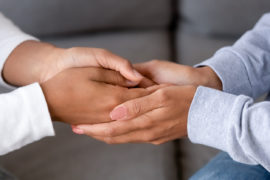 You don’t need the Diagnostic and Statistical Manual (DSM) to tell you that one of the most paralyzing symptoms of your Borderline Personality Disorder (BPD) is a fear of abandonment. The DSM describes the symptom as “extreme reactions – including panic, depression, rage, or frantic actions – to abandonment, whether real or perceived.”
You don’t need the Diagnostic and Statistical Manual (DSM) to tell you that one of the most paralyzing symptoms of your Borderline Personality Disorder (BPD) is a fear of abandonment. The DSM describes the symptom as “extreme reactions – including panic, depression, rage, or frantic actions – to abandonment, whether real or perceived.”
The key factor here is “whether real or perceived.” It doesn’t matter, because the fear feels the same. Questioning whether or not the fear is founded in reality or is just paranoia only leads to more self-doubt.
This symptom can throw a significant wrench into the works once you have decided to seek treatment for your Borderline Personality Disorder. Not only will you need the emotional support of friends and family members, you will need to get past your fear of accepting support and connecting with others so that you can build a relationship with your therapist, who will be the most invaluable ally in your journey to living a life free of BPD symptoms. Feeling comfortable with your therapist and with the BPD treatment center you choose is key.
Find the Right BPD Treatment Center
The first step to feeling comfortable is to educate yourself. Knowledge is power. Gaining an understanding of the many options of treatment for Borderline Personality Disorder will help you find the BPD treatment center that is the best fit for you. Call around, make appointments to visit, get a sense of what the center is about.
Ask questions. Is it a holistic Borderline Personality Disorder treatment center? Is it a women’s BPD treatment center? What are the qualifications of the therapist you will be working with? How much one-on-one time can you expect to spend with your therapist? Does the treatment center offer dual diagnosis and help in treating disorders that frequently co-occur with BPD, such as eating disorders and depression?
Identify what’s important to you in a BPD treatment center, then choose the one that not only satisfies your requirements, but “feels right.”
Letting Your BPD Therapist In
Other symptoms of Borderline Personality Disorder include paranoia and difficulty maintaining relationships, not to mention the fact that BPD also often co-occurs with social anxiety. Revealing painful truths about yourself to a therapist is difficult for anyone, let alone for someone who is experiencing these emotions.
The whole point of beginning a patient/therapist relationship is to have someone with whom you can feel safe. This will require your letting your BPD therapist in.
Here are some tips for doing that:
- Try to remember, your BPD therapist is there to heal you, not hurt you.
- Remember that you are not the first patient to deal with problems opening up. Your therapist is not judging you or grading you on your performance.
- Remind yourself of why you are there – it may be helpful to make a mental list of your goals with therapy. Visualize past therapy and imagine what a life without fear of connecting with others would feel like.
- Keep in mind that working with your therapist is a relationship, not a one-way street. Your BPD therapist will find ways to help you open up.
- There are many holistic treatment centers for Borderline Personality Disorder that offer classes in yoga and meditation. These can give you the tools to get more in touch with your emotions and help you be freer in your work with your therapist, both individually and in group therapy.
Accept Help
Make no mistake about it, working toward healing when you have Borderline Personality Disorder is an uphill battle. The support of friends, family, and your therapist is one of the strongest weapons in your arsenal against the disorder.
Despite any predisposition you might have had in the past against accepting help from others, you must realize that accepting help does not make you any more vulnerable. Quite the opposite.
A few things to remember:
- Accepting help when you need it is a sign of strength, not weakness.
- A chain is only as strong as its weakest link. You are important to your friends and family. It helps them to help you.
- Communication is the most important part of any relationship. Let others know how you are truly feeling about their support. This can guide them in helping you, and gives you the opportunity to practice connecting and building or re-building strong relationships.




1 Comment
Pingback: Finding Support for Borderline Personality Disorder